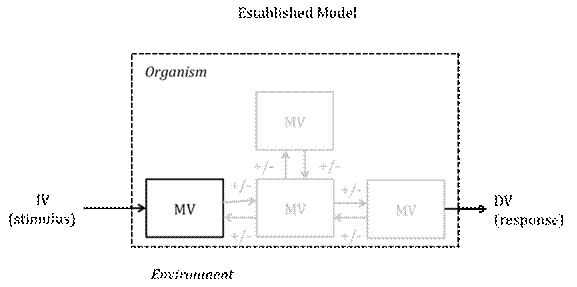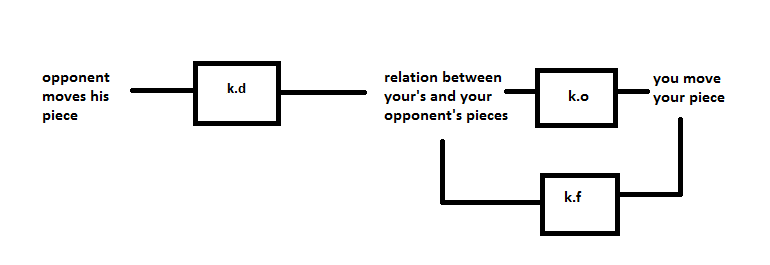···
On Wed, Mar 14, 2018 at 3:23 PM, PHILIP JERAIR YERANOSIAN pyeranos@ucla.edu wrote:
[philip 2018.03.14]
I did not say “your moves are responses to the opponent’s moves”. I said " your moves are responses to your opponent’s response to the relations created by your move".
On Wed, Mar 14, 2018 at 3:00 PM, Martin Taylor mmt-csg@mmtaylor.net wrote:
[Martin Taylor 2018.03.14.17.16]
Philip, it maybe before your time, but we learned to keep separate a
bunch of different viewpoint when looking at situations like this.
There is the “Observer” who can see only the effects controllers
make on their common external environment; there is the controller,
who is said to see only what the relevant perceptual functions
produce as perceptual signals; and there is the “Analyst” who can
theorize about all the signal levels in all the signal paths. I
think that in this message you are mixing up viewpoints in a
confusing way, being mostly “analyst” but sometimes “controller”.
[philip 2018.03.14]
Here is the PCT diagram that I agree with.
That is an Analyst’s view
Here is what the interaction between two chess players
looks like.
I don't understand this one, if it is not intended to put specific
examples of the perceptual control by one player of a perception of
the relationships among the pieces (really a large number of
interdependent perceptions).
Here is a better diagram of the interaction between two
chess players.
This diagram appears to be a mash-up of an analyst's view of
symmetric control loops of two players controlling perceptions of
what ought to be the same environmental situation, but it isn’t. It
is an observer’s view, since it deals only with the observable
behaviour. The “relations between your and your opponent’s pieces”
is a mystery, since the moves at the left and right ends of the
diagram act on the placement of the pieces on the board, and the
relationships perceived by the two players are different. They must
be, because if they were not, every game would end in a draw or a
very early concession.
There is one higher-level conflict that is assumed in every
competitive game, whether it be team or individual. Each is
controlling for being perceived to have won the game, but there is a
resource limitation, in that only one player can win.
Environmentally, there are a bunch of “the same” board layouts that
together form the reference pattern of pieces for each player, but
only one t most of the sets can be brought to its reference value of
“the other king in checkmate” at the end of the game. Maybe neither
will be, as is often the case in a resource limitation conflict.
I would draw two separate control loops, one for each player
controlling his or her perception of the relationships among the
pieces on the board, with the output being a move. That move affects
the layout, and thus disturbs the opponent’s perception of the
relations, which is being controlled with an action output
consisting of “opponent’s move”. There is in this way a loop of the
same form as that of a classic resource conflict. The limited
resource is the board layout, and the only variable controlled by
both players that has a common environmental correlate is the
perception “the other king is in checkmate”.
The
feedback function in the third diagram, k.f, refers to the
“laws of chess”, which are the rules which govern the
relations of the chess pieces (i.e. the bishop capture
diagonally, etc.). As such, the feedback function, k.f,
determines the relation between your’s and your opponent’s
pieces after a move is made (for example, after moving his
own bishop onto the diagonal, white’s bishop can capture
black’s bishop along the diagonal). This feedback function I
am currently referring to in the third diagram, k.f, is the
same as the disturbance function in the first and second
diagrams, k.d, which is the same as the environmental
function in
Rick’s diagram in the “the blind men and the elephant”
paper , k.e, which is a feedback function that is
missing or incomplete in Warren’s diagram. Thus, I do not
accept your recommendation of Warren’s diagram in its place,
with no disrespect, Bruce.
And now, Bruce, to answer your question:
Q:
“What important difference are you expecting to see between
the value d and the value (k.e * d), and how are any such
differences relevant to the variables being controlled?”
A:
There is no significant difference between the value d and
the value (k.f * d). However, the value of d now depends on
your behavior, and the inverse is also obviously true (that
the behavior depends on the disturbance). But only the truth
of the inverse is apparent in Warren’s diagram.
Now, here comes the fun. We may intuit that your moves are
made in response to the relations created by your opponent’s
move (relations which were created by the “laws of chess”).
And naturally your opponents moves are made in response to
relations created by your own moves. But importantly, now we
can say that your moves are made in response to your
opponent’s response to the relations created by your move. And
finally, the magic: i f
a relation you have created in a previous turn remains
undisturbed by the opponent and thus propagates into your
current turn, we can say that control causes
variation in k.o by creating memory. Because now we can move
relations instead of pieces. And now your opponent’s behavior
is made in response to relations created by your “movement of
relations”. And when we move relations, we are “varying the
pieces as necessary” (thus engendering the “laws of
behavior”).
That's a very S-R (anti-PCT) view of what is going on, is it not?
Multi-level control (moving relations instead of pieces) is standard
PCT, but your moves as responses to the opponent’s moves is not.
Taking a controller's view, the standard PCT way of saying it would
be the way I did it above: your moves are intended to disturb the
opponents perception of the relationships, in a way that the
opponent perceives as changes the perceptual distance from a winning
position. You made your move so as to bring your perception of the
game closer to your reference value of the opponent’s king being in
checkmate, and you intend, though you cannot know, that your
opponent does not see how this is true. Ideally, you would be
controlling for the opponent to perceive your move as moving the
game play nearer to your losing (perceiving you made a mistake), but
in a game in which all moves are visible, that’s hard to do. It is
more likely that if you perceived your move as bringing the game
state nearer your reference value, the opponent will see the same.
From the Analyst's viewpoint, you would say much the same, probably
using names to make it easier to treat the entire set of feedback
loops within the two players individually and through both of them
together. What the Observer sees depends on the observer’s skill as
a chess player, but it is unlikely that it will be the same as what
either of the players sees, possibly unless all three are super
Grand-Masters or computers that have the same programming and
experience.
Or maybe you just made an unfortunate choice of words, and you
didn’t mean their S-R connotation at all.
Martin

Virus-free.
www.avast.com
On Wed, Mar 14, 2018 at 10:59 AM, Bruce
Nevin bnhpct@gmail.com
wrote:
[Bruce Nevin 2018-03-14_13:59:04 ET]
This diagram is on p. 25, a reprint of "The blind
men and the elephant: Three perspectives on the
phenomenon of control." The original publication in * Closed
Loop *3.1 is here, on pp. 37-46:
http://www.pctresources.com/Journals/Files/Closed_Loop/Closed_Loop_read/Closed_Loop_vol3_%231_read.pdf
I think all that k.e means is that the disturbance
d takes effect on the sensory input (s in Rick’s
diagram, not p) by way of physical properties of the
environment.
Just as s is on the left, r is on the right,
evoking a parallel to an s-r explanation that relies
upon an ‘organism function’ between s and r. Rick’s
k.o is an ‘organism function’ that comprises sensors
(and higher-level input functions), reference
signal(s), comparator(s), error signal(s), and
effector(s) which produce r at the output. The diagram
is drawn that way to facilitate the comparison with
the concepts of s-r and ‘cognitive’ psychology. I
recommend Warren’s diagram in its place.
The interaction between two chess players requires
two such control diagrams, each controlling its
perceptions of a rather complex field of variables.
Most of this control is in imagination. Control by
each is disturbance to control by the other, including
what each imagines the other to be controlling. That
calls for a pretty complex binary diagram.
Now, what about k.e? When one of them closes the
control loop through the environment affecting the
disposition of variables that are ‘also’ controlled by
the other, that is a disturbance d in the
environment, but given the highly structured
environment on the chessboard what important
difference are you expecting to see between the value
d and the value (k.e * d), and how are any such
differences relevant to the variables being
controlled? The bishop may be off-center on this side
or that of its square, but it still ‘projects’ its
‘influence’ (and is vulnerable) along those two diagonals
centered on that square.
/Bruce
On Wed, Mar 14, 2018 at 10:58
AM, PHILIP JERAIR YERANOSIAN pyeranos@ucla.edu
wrote:
I
was hoping we could discuss a chess game via “The
Cognitive View”.
Please view the first attached figure, which
is copied from p. 25 of More Mind Readings.
And next view the second figure, which is
the first figure applied to a game of chess.
I find that the disturbance function
(labeled k.e) is important in understanding
exactly what the controlled variable is.







